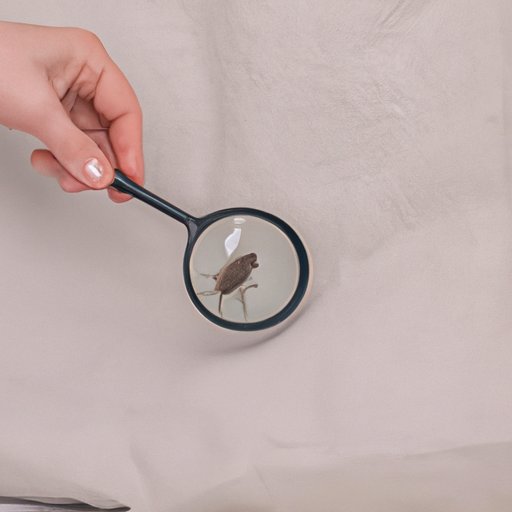I. Introduction
Bed bugs are a common pest problem in homes, causing discomfort, bites, and in some cases, even health issues. Detecting bed bugs early can save you from a severe infestation, so it is crucial to identify these pests as soon as possible.
This guide will help you explore various methods to find bed bugs in your home and surrounding areas.
II. How to Visually Inspect Your Bedding
Bed bugs leave behind several visual signs such as bloodstains, molted skins, and fecal spots, which can help identify their presence on your bedding.
You can check your bedding for small, red spots on your sheets or bed frames. These spots indicate bed bug fecal matter. You can also look for bloodstains on your bedding or small molted skins on your mattress or pillows. If you see any of these signs, you may have a bed bug infestation, and it is time to take action.
You may also find live bed bugs or eggs on your bedding, as these pests are most active at night and tend to hide during the day. Look for them in the seams, folds, and crevices of your bedding, including your pillows, sheets, and mattress.
To perform an effective visual inspection, it is crucial to use a magnifying glass and a bright light source to detect any small signs of bed bugs.
III. Using a Flashlight
A flashlight can help you find bed bugs in hidden places where they may be challenging to see with the naked eye.
To get started, check for bed bugs in areas where they commonly hide, such as the seams of your mattress, crevices in your bed frame, and behind your headboard.
When searching with a flashlight, focus on small crevices and hidden areas. You can use a flashlight or even a smartphone light to check your bedding and furniture to identify any locations where bed bugs may be hiding.
IV. Sticky Tape Traps
Sticky tape traps are a simple yet effective method to detect bed bugs in your home. They work by trapping bed bugs as they try to cross a sticky surface, essentially creating a barrier between you and these pests.
To make a sticky trap, wrap double-sided tape around the legs of your bed or other furniture where you suspect bed bugs may be hiding. Change the tape frequently, and inspect them under a bright light source to identify any bed bugs that may have been caught.
Place traps in areas where bed bugs usually hide, such as around your bed frame, behind your headboard, and alongside your baseboards.
V. Hiring a Professional
If you are struggling to detect bed bugs in your home, consider hiring a professional pest control company to diagnose and treat your infestation.
A pest control expert will identify hiding spots and use various techniques to control and eliminate the infestation entirely. These methods may consist of heat treatment, pesticides, or other bed bug treatment options.
When hiring a professional, it is essential to choose a reputable company with a proven track record of success. Be cautious of companies that promise extermination within a short time, as this may not be feasible in severe cases.
During a typical bed bug inspection, the pest control expert will check for signs of bed bugs, including mattress seams, bed frames, and other hiding spots, and use different tools and techniques to detect them.
VI. Bed Bug Detection Dogs
Bed bug detection dogs are specially trained to detect bed bugs with their keen sense of smell. These dogs can detect even a few bed bugs in an area, which may be difficult or impossible to find using other methods.
To find a reputable company that uses bed bug detection dogs, check their certifications and reputation carefully. Some companies may attempt to pass off untrained dogs as bed bug detection dogs, which is not reliable or accurate.
Using a bed bug detection dog can be an efficient method to detect bed bugs, especially in large homes or tricky hiding spots that are harder to reach.
VII. Using Bed Bug Monitors
Bed bug monitors are designed to attract bed bugs and trap them inside a device, which can help identify the scope of your infestation. Monitors can be set up under bed legs or around your mattress and can even be used during travel.
However, bed bug monitors have their limitations, as they are not always efficient in detecting low infestation levels. It is essential to use these devices as part of a broader bed bug management plan.
VIII. Conclusion
The key to effective bed bug management is to detect these pests early. By following the tips and methods outlined in this guide, you can identify any infestations in your home and apply appropriate treatments.
If you are struggling with a severe bed bug infestation, it is essential to call in a professional pest control company to assist you. Remember, the earlier you detect bed bugs, the easier it will be to get rid of them successfully.
